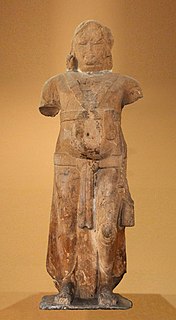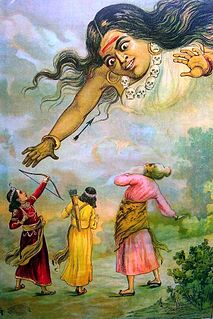 W
WThe yakshas are a broad class of nature-spirits, usually benevolent, but sometimes mischievous or capricious, connected with water, fertility, trees, the forest, treasure and wilderness. They appear in Hindu, Jain and Buddhist texts, as well as ancient and medieval era temples of South Asia and Southeast Asia as guardian deities. The feminine form of the word is yakṣī or yakshini.
 W
WAgnipani was a Yaksha deity in ancient India. His name means "Agni-holder", "Agni" being the fire, for which the later god Agni is well known. The Mathura Museum describes his statue as "Agnipani Yaksha", but Sonya Rhie Quintanilla simply identifies the statue as that of the Vedic God Agni.
 W
WĀṭavaka is a popular figure in Buddhism. He is a yakṣa and regarded as a Wisdom King in esoteric tradition.
 W
WThe Bhutesvara Yakshis, also called the Bhutesar Yakshis are a series of yakshi reliefs on a railing, dating to the 2nd century CE during the time of the Kushan Empire. The reliefs were found in the Bhutesar mound, around the remains of a Buddhist stupa, outside Mathura, and are now located in the Indian Museum in Kolkata, with three pillars, and three more pillars and one fragment in the Mathura Museum. They are an important example of Mathura art, of which these and other yakshi figures are "perhaps the best known examples".
 W
WThe Didarganj Yakshi is one of the finest examples of very early Indian stone statues. It used to be dated to the 3rd century BCE, as it has the fine Mauryan polish associated with Mauryan art. But this is also found on later sculptures and it is now usually dated to approximately the 2nd century CE, based on the analysis of shape and ornamentation, or the 1st century CE. The treatment of the forelock in particular is said to be characteristically Kushan.
 W
WThe Eight Great Yakṣa Generals, or simply the Eight Yakṣa Generals are guardian deities in Buddhism. They are retainers of Vaiśravaṇa, guardian of the north and king of the yakṣas.
 W
WHārītī (Sanskrit), also known as Chinese: 鬼子母(神), Pinyin: Guǐzǐmǔ(shén), Japanese Kishimojin (鬼子母神), is both a revered goddess and demon, depending on the Buddhist tradition. In her positive aspects, she is regarded for the protection of children, easy delivery and happy child rearing, while her negative aspects include the belief of her terror towards irresponsible parents and unruly children.
 W
WDewa tribe of Sinhalese in Sri Lanka is the only ancient Sinhalese tribe which still could be recognize in the island who founded Sinhalese nationality. There family names bearing distinct "Dewage" as surname. Deva, Wahumpura, Wanshapurna are the other names. They are mountain dwelling people even at present.
 W
WInuyasha is a Japanese manga series written and illustrated by Rumiko Takahashi. The series begins with Kagome Higurashi, a fifteen-year-old middle school girl from modern-day Tokyo who is transported to the Sengoku period after falling into a well in her family shrine, where she meets the half-dog demon, half-human Inuyasha. After the sacred Shikon Jewel re-emerges from deep inside Kagome's body, she accidentally shatters it into dozens of fragments that scatter across Japan. Inuyasha and Kagome set to recover the Jewel's fragments, and through their quest they are joined by the lecherous monk Miroku, the demon slayer Sango, and the fox demon Shippo. Together, they journey to restore the Shikon Jewel before it falls into the hands of the evil half-demon Naraku.
 W
WKubera also known as Kuvera, Kuber or Kuberan, is the god of wealth and the god-king of the semi-divine Yakshas in Hindu culture. He is regarded as the regent of the North (Dik-pala), and a protector of the world (Lokapala). His many epithets extol him as the overlord of numerous semi-divine species and the owner of the treasures of the world. Kubera is often depicted with a plump body, adorned with jewels, and carrying a money-pot and a club.
 W
WManibhadra is one of the major yakshas. He was a popular deity in ancient India.
 W
WIn the Hindu epic Ramayana, Maricha, or Mareecha is a rakshasa (demon), who was killed by Rama, the hero of the epic and an avatar of God Vishnu. He is mentioned as an ally of Ravana, the antagonist of the epic. His most notable exploit is his role in the kidnapping of Sita, Rama's wife. His son Kalanemi was killed by Hanuman.
 W
WMudgarpani was a Yaksha deity in ancient India. His name means "Mudgar-holder", the Mudgar being an ancient form of heavy cub, usually made of wood, but it can also be made of iron.
 W
WNalakūvara, also known as Nalakūbara, appears in Hindu and Buddhist mythology as the brother of Maṇigrīva, the son of the yaksha king Kubera and husband of Rambha. Nalakūvara often appears as a sexual trickster figure in Hindu and Buddhist literature.
 W
WPañcika is a yaksha and consort of Hārītī, with whom he is said to have fathered 500 million billion trillion children.
 W
WThe Parkham Yaksha is a colossal statue of a Yaksha, discovered in the area of Parkham, in the vicinity of Mathura, 22.5 kilometers south of the city. The statue, which is an important artefact of the Art of Mathura, is now visible in the Mathura Museum. It has been identified as the Yaksha deity Manibhadra, a popular deity in ancient India.
 W
WThe Pompeii Lakshmi is an ivory statuette that was discovered in the ruins of Pompeii, which was destroyed in the eruption of Mount Vesuvius 79 CE. It was found by Amedeo Maiuri, an Italian scholar in 1938. The statuette has been dated to the first-century CE. The statuette is thought of as representing an Indian goddess of feminine beauty and fertility. It is possible that the sculpture originally formed the handle of a mirror. The Lakshmi is evidence of commercial trade between India and Italy in the first century CE.
 W
WTaraka or Tadaka or Thataka was a demoness in the epic Ramayana. Along with her children, Maricha and Subahu, Taraka would harass and attack rishis performing yajnas in the forest. They were ultimately slain by Rama and Lakshmana on behest of their teacher, maharishi Vishwamitra.
 W
WIn East Asian Buddhism, the Twelve Heavenly Generals or Twelve Divine Generals are the protective deities, or yaksha, of Bhaisajyaguru, the buddha of healing. They are introduced in the Bhaiṣajyaguruvaidūryaprabharāja Sūtra. They are collectively named as follows:simplified Chinese: 十二神将; traditional Chinese: 十二神將; pinyin: Shí'èr Shén Jiāng Japanese: Jūni Shinshō (十二神将) or Jūni Shinnō (十二神王) or Jūni Yakusha Taishō (十二薬叉大将)
 W
WVaiśravaṇa (Sanskrit) or Vessavaṇa, is one of the Four Heavenly Kings, and is considered an important figure in Buddhism.
 W
WVajrapāṇi is one of the earliest-appearing bodhisattvas in Mahayana Buddhism. He is the protector and guide of Gautama Buddha and rose to symbolize the Buddha's power.
 W
WYakshinis a class of nature spirits in Hindu, Buddhist, and Jain religious mythologies that are different from devas (gods), asuras (demons), and gandharvas or apsaras. Yakshinis and their male counterparts, the yakshas, are one of the many paranormal beings associated with the centuries-old sacred groves of India.